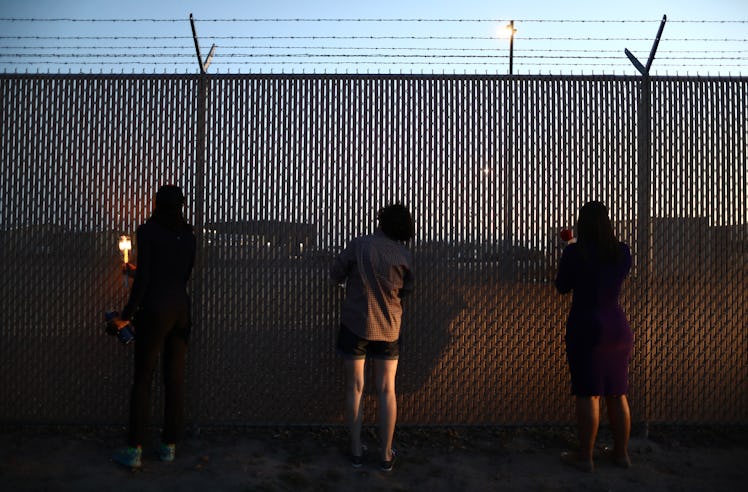
These Horrified Reactions To A Drowned Migrant Child & Father Blame Border Policies
While the country debates immigration policy and what to call camps where migrant children are detained, migrants themselves are taking risks out of desperation. On June 24, one family's risks ended in tragedy, when a father and daughter drowned while reportedly trying to cross the Rio Grande to claim asylum in the United States. Now, these reactions to a drowned migrant child and her father are prompting people to question the border policies that may have contributed to the tragedy.
Warning: this story contains graphic content.
On June 25, the internet and America was shocked by a graphic photo showing the drowned bodies of a man and young daughter who had reportedly been attempting to cross the Rio Grande near Brownsville, Texas in order to claim asylum in the United States. According to the Associated Press, the bodies were that of Óscar Alberto Martínez Ramírez and his daughter Valeria. The family, which included Martínez's wife Tania Vanessa Ávalos, was reportedly traveling from El Salvador. According to the AP, Martínez swam the river with his daughter, and then turned back to help his wife across. When the young child saw her father turning back, she reportedly "threw herself" after him, according to the account from Ávalos, who reportedly witnessed the incident. The current swept father and daughter away.
The photo of the two, which Elite Daily has not included in this story, shows the bodies of Martínez and his daughter face down in the shallow waters of the riverbank at Matamoros, Mexico. Per Vox, the family had been staying in a migrant camp on the Mexico side of the border, which reportedly had high temperatures and little food.
The photo, which hit American media on June 25, drew instant outrage. On social media, public figures and private citizens alike shared their horror, and questioned who and what was to blame for the deaths.
In May 2018, the U.S. government began a practice called "metering" at the southern U.S. border, essentially limiting the number of migrants who could be processed to enter the United States each day. Migrants waiting to enter were required to stay in Mexico. As of May 2019, some 19,000 migrants were waiting to enter the United States, according to a report from the Robert Strauss Center at U.T. Austin and the Center for U.S.-Mexican Studies at U.C. San Diego. According to Public Radio International (PRI), most migrants wait one to two months to even request asylum. In October 2018, then-CBP Commissioner Kevin McAleenan defended the practice, saying, "It’s not turning people away, it’s asking them to wait." Elite Daily reached out to the Department of Homeland Security (DHS) regarding criticism that immigration policies and metering were responsible for the deaths, but did not immediately hear back.
Congress too has been criticized for inaction. In a joint letter to Congress, the Department of Health and Human Services (HHS), which cares for unaccompanied migrant children, and DHS called the situation at the border a "humanitarian and security crisis" and called on the legislative branch to pass $4.5 billion in emergency funding. The emergency bill passed the House of Representatives on June 25.
Immigration at the southern U.S. border has been described by advocates and officials alike as a humanitarian crisis, with the number of undocumented migrants entering the United States hitting an 11-year high in February 2019. Many of these migrants are Central Americans fleeing violence or instability in their home countries — while The New York Times points out that exact numbers are unknown, many migrants intend to pursue legal asylum claims once they are on U.S. soil.
However, U.S. officials have repeatedly changed policies regarding asylum claims in recent months. In November 2018, the U.S. government began a policy requiring migrants to present themselves at official ports of entry to claim asylum, where they may have to wait days or even weeks to be able to enter the country. Reports also emerged that officials were turning migrants away, something that DHS denied. In January 2019, the Trump administration instituted a policy requiring asylum seekers at the southern border to wait in Mexico while their asylum claims were processed, a policy upheld in court in April.
With more than 144,000 migrant apprehensions in May of 2019 alone, per Customs and Border Protection (CBP) data, this crisis is not ending anytime soon. In the meantime, here are some ways to help migrant children and families at the border — because we can all do something.